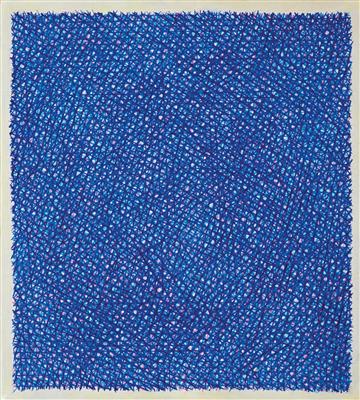Piero Dorazio *

(Rome 1927–2005 Perugia)
Chiar di luna, 1962, signed, dated and titled on the reverse, oil on canvas, 71 x 64 cm, framed
This work is registered in the Archivio Piero Dorazio, Milan and it is accompanied by a photo-certificate of authenticity.
Provenance:
Marlborough Gallery, New York (label on the reverse)
Mara Coccia Collection (Galleria Arco d’Alibert), Rome
Giorgio De Domincis Collection, Rome
European Private Collection
As an object of study in space, conversing with light and colour, the line has been a fundamental component for Dorazio from the the beginning of his research. As Kandinsky taught, line and colour must be in continuous communication. It is in the late fifties that Dorazio’s painting arrives at the idea of the surface as a continuous field and undertakes an meticulous analysis of the colour-light complex, resulting in a sequence of works characterised by “dense, very thin chromatic warp, still rich in atmospheric and emotional evocations”.
(Filiberto Menna, Le correnti pittoriche non oggettive degli anni Sessanta, Fratelli Fabbri editori, Milan 1975, in L’arte Moderna, vol. XIII, p. 121)
“It is in the grid that the interest in the pure form and the concreteness of painting are merged with an extended perceptive investigation, in which the sense of volume, space and depth are joined to a complex and cerebral idea of colour. It is where time enters the painting to give new meaning to the elements permeating deep down, granting them different attributes and connotations. The surface becomes a relationship between figure and background, a relationship so intriguing that it permeates the whole atmosphere of the paintings — not so much for the texture itself, but for the crossing of lines in a paradoxically rational tangle, for the transparency of a colour so mature and knowing that it is able to affirm itself while giving voice to a deep space, divided into planes — a bit like it is with the wings of a theatre, where a separation exists, but where it is also possible to connect, to move from one area to another, passing in front of and behind the panels. This is what form is for Dorazio — that which creates space, activates a situation where time, in such a continuous potentiated movement, creeps between the parts and gives them new meaning ...” “the look investigates, creates a sense, a path, a structure in the grid, looks at the rationality, gets lost in the tangle, runs forward and backward, stops and then starts again, tracing all the while that temporal flow which, following the work at hand, either accelerates (as in the early Sixties) or, with time, slows down, grows wider and lighter…”
(Elena Forin, Piero Dorazio exhibition, Anfiteatro Arte, February 2007)
Dorazio does not like to hear his luminous weaves be called “grids” because, according to him, this improper denomination reveals a deep misunderstanding of his intentions and leads to a confusion given that “grid” implies a rigid arrangement of lines, drawn in a mechanical way on a flat and uniform background. Dorazio believes instead that painting, to be modern, must free itself from drawing. He considers it a fundamental conquest of the art of our century that colour is no longer limited to the outline, or background, of drawing, in other words — that it is no longer subordinate to it. (...) The weave of his works is not the product of drawing and the lines are born in the application of colour with the tip of the brush — all courtesy of a manual dexterity that leaves on the canvas light yet apposite touches of colour.”
(N. Vernizzi, quoted in Piero Dorazio. Gli anni Sessanta, Milan 1998, p. 35)
Executed in 1962, “Chiar di Luna”, is certainly a fine example of this style of abstraction that characterises the period of the artist’s work from 1958 to 1963, which can be considered the peak of his career. The canvas radiates light, the composition is homogeneous, vibrant. A set of superimposed thin lines in various tones of blue and red create a harmonious whole. The eye gets lost in this tangle of “threads” that intertwine on various planes creating a dynamic and balanced surface, rich in depth.
Specialist: Alessandro Rizzi
 Alessandro Rizzi
Alessandro Rizzi
+39-02-303 52 41
alessandro.rizzi@dorotheum.it
25.11.2020 - 16:00
- Realized price: **
-
EUR 137,500.-
- Estimate:
-
EUR 80,000.- to EUR 120,000.-
Piero Dorazio *
(Rome 1927–2005 Perugia)
Chiar di luna, 1962, signed, dated and titled on the reverse, oil on canvas, 71 x 64 cm, framed
This work is registered in the Archivio Piero Dorazio, Milan and it is accompanied by a photo-certificate of authenticity.
Provenance:
Marlborough Gallery, New York (label on the reverse)
Mara Coccia Collection (Galleria Arco d’Alibert), Rome
Giorgio De Domincis Collection, Rome
European Private Collection
As an object of study in space, conversing with light and colour, the line has been a fundamental component for Dorazio from the the beginning of his research. As Kandinsky taught, line and colour must be in continuous communication. It is in the late fifties that Dorazio’s painting arrives at the idea of the surface as a continuous field and undertakes an meticulous analysis of the colour-light complex, resulting in a sequence of works characterised by “dense, very thin chromatic warp, still rich in atmospheric and emotional evocations”.
(Filiberto Menna, Le correnti pittoriche non oggettive degli anni Sessanta, Fratelli Fabbri editori, Milan 1975, in L’arte Moderna, vol. XIII, p. 121)
“It is in the grid that the interest in the pure form and the concreteness of painting are merged with an extended perceptive investigation, in which the sense of volume, space and depth are joined to a complex and cerebral idea of colour. It is where time enters the painting to give new meaning to the elements permeating deep down, granting them different attributes and connotations. The surface becomes a relationship between figure and background, a relationship so intriguing that it permeates the whole atmosphere of the paintings — not so much for the texture itself, but for the crossing of lines in a paradoxically rational tangle, for the transparency of a colour so mature and knowing that it is able to affirm itself while giving voice to a deep space, divided into planes — a bit like it is with the wings of a theatre, where a separation exists, but where it is also possible to connect, to move from one area to another, passing in front of and behind the panels. This is what form is for Dorazio — that which creates space, activates a situation where time, in such a continuous potentiated movement, creeps between the parts and gives them new meaning ...” “the look investigates, creates a sense, a path, a structure in the grid, looks at the rationality, gets lost in the tangle, runs forward and backward, stops and then starts again, tracing all the while that temporal flow which, following the work at hand, either accelerates (as in the early Sixties) or, with time, slows down, grows wider and lighter…”
(Elena Forin, Piero Dorazio exhibition, Anfiteatro Arte, February 2007)
Dorazio does not like to hear his luminous weaves be called “grids” because, according to him, this improper denomination reveals a deep misunderstanding of his intentions and leads to a confusion given that “grid” implies a rigid arrangement of lines, drawn in a mechanical way on a flat and uniform background. Dorazio believes instead that painting, to be modern, must free itself from drawing. He considers it a fundamental conquest of the art of our century that colour is no longer limited to the outline, or background, of drawing, in other words — that it is no longer subordinate to it. (...) The weave of his works is not the product of drawing and the lines are born in the application of colour with the tip of the brush — all courtesy of a manual dexterity that leaves on the canvas light yet apposite touches of colour.”
(N. Vernizzi, quoted in Piero Dorazio. Gli anni Sessanta, Milan 1998, p. 35)
Executed in 1962, “Chiar di Luna”, is certainly a fine example of this style of abstraction that characterises the period of the artist’s work from 1958 to 1963, which can be considered the peak of his career. The canvas radiates light, the composition is homogeneous, vibrant. A set of superimposed thin lines in various tones of blue and red create a harmonious whole. The eye gets lost in this tangle of “threads” that intertwine on various planes creating a dynamic and balanced surface, rich in depth.
Specialist: Alessandro Rizzi
 Alessandro Rizzi
Alessandro Rizzi
+39-02-303 52 41
alessandro.rizzi@dorotheum.it
|
Buyers hotline
Mon.-Fri.: 10.00am - 5.00pm
kundendienst@dorotheum.at +43 1 515 60 200 |
| Auction: | Contemporary Art I |
| Auction type: | Saleroom auction with Live Bidding |
| Date: | 25.11.2020 - 16:00 |
| Location: | Vienna | Palais Dorotheum |
| Exhibition: | online |
** Purchase price incl. charges and taxes
It is not possible to turn in online buying orders anymore. The auction is in preparation or has been executed already.
